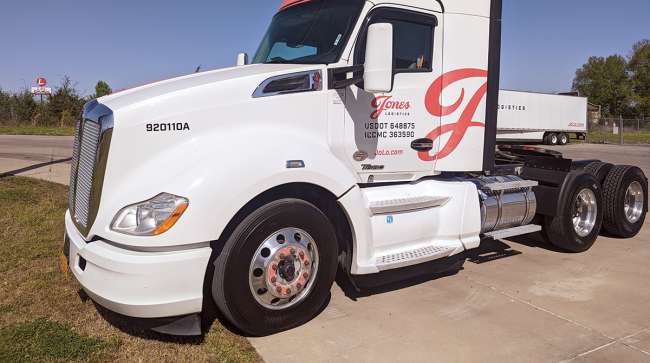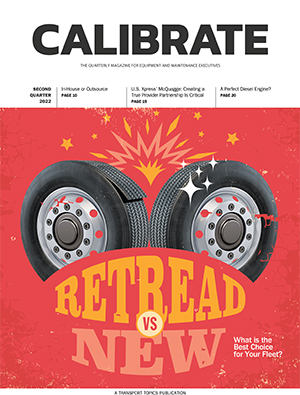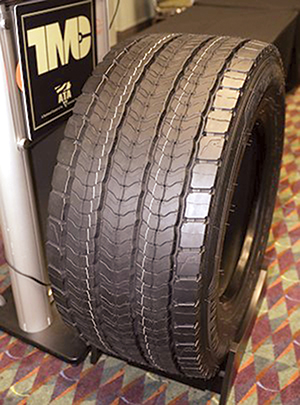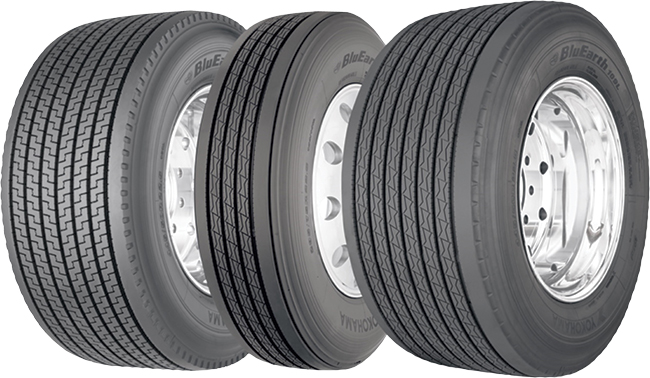Contributing Writer
Tire Choices Provide Pros, Cons for Fleet Maintenance Managers

[Find the latest in equipment & maintenance: Explore this quarter's issue of Calibrate]
In the current environment of high fuel prices and a technology shift looming over many companies regarding last-mile delivery, fleets are challenged to develop a strategy toward tire management. For some maintenance managers, the debate of new tires versus retreads offers various methods in battling some of those concerns.
Ken Eggen, executive vice president of assets, maintenance and safety at Jones Logistics, has used retreads for some time and feels there’s plenty of upside and there have been advances to the practice, noting that pricing hasn’t escalated at the same levels as new tires.
“I’ve always thought [retreading] is the right thing to do,” Eggen said. “The retreading process is more refined now, whether it’s what Love’s is doing with the Oliver product, or the Michelin MRT, or the Bandag product, or even the Goodyear Wingfoot product. ... They’re excellent products; much better than what we were seeing 10 years ago.”

More Q2 Calibrate
►Tire Choices Provide Pros, Cons for Fleet Maintenance Managers
►Send Out Your Maintenance Labor, or Keep It in the Fleet Shop?
►Five Questions: Greg McQuagge, U.S. Xpress
►Freeze: Winning the Hearts and Minds
►TMC Corner: Warming Up to Smart Trailer Tech for Cold Chain Logistics
►Baxter: Will the Diesel Engine Ever Be Perfected?
Explore the Issue!
However, new tires can still make sense for some fleets, depending on the situation, said Mike Steiner, customer engineering support time zone referent at Michelin North America Inc.
“Michelin works with fleets on an ongoing basis in the testing and development of tires and retreads. Their input is critical,” he said. “With that said, fleets should consider their overall business needs, such as uptime and operational efficiencies, and evaluate what tires or retreads are best suited to support their business needs on a tire, retread and service level.”
Steiner noted that fleets need to understand their vehicles’ intended use and operational needs, and prioritize the key success factors for the operation, including wear, fuel costs, mileage, traction, vehicle weight, payload weight and, of course, driver satisfaction.
The Case for Retreads
Lowering costs, or more specifically, cost per mile, is a significant reason why retreading has remained a widespread practice for many years. There are many different types and qualities of retreads now available. Steiner said that the retread processes and products have advanced during the last 20-25 years and deliver measurable value to fleet customers.
“For the fleets that choose to retread, they can save themselves a significant amount of money when managed properly,” Steiner asserted. “Retreads can deliver performance similar to a new tire for much less.”
Retread costs are determined by many factors, including the price of raw materials, the volume sold in each category, purchase mix and quality. It will also vary among dealers. The retreading process has improved significantly. Still, Eggen takes it a step further, stating that the retread manufacturer’s process is the key deciding factor for using these products.

ATA's Glen Kedzie and Transport Topics' Eric Miller dive into the realities and challenges of the proposed new NOx standard, what it means for truck manufacturers and for the industry's electric future. Tune in above or by going to RoadSigns.TTNews.com.
“I’ve been in several retread plants over the years to understand the differences, whether it’s how they put the cushion gum on to how the tread itself is applied to the gum, the splice, all those things that come into play,” he said. “Frankly, the newer the machinery or the technology in the plants, the better the process is because many of the retread plants even today have 25-year-old technology in there. So the guys that have come into the mix more recently saying they’ve had to tool up with the newer [equipment] have refined the process. They’re making an excellent product today.”
Eggen says that material and casing shortages have not played out so far from his perspective. “We keep hearing that we were going to be seeing new tire shortages for the last year, but that’s been spotty,” he explained. “We haven’t incurred much of that because of the various tires we run on the new side, and there have been plenty of casings out there.”
Eggen adds that he likes to use a Tier 1 casing such as a Goodyear, Bridgestone, Michelin or Yokohama, but even “the Tier 2 guys” have some good casings now with five- to seven-year warranties. “The warranties on the casings go above and beyond most fleets’ ability to manage through that process,” he said.

Goodyear’s Endurance RSA ULT is geared toward the EV market. (Goodyear)
Tires are one of the most significant maintenance expenses for trucking companies, so there are a lot of factors that influence tire buying decisions. Warranties on tire casings help, but that doesn’t change the trajectory because driver training also plays a role.
“I’ve been around enough fleets on a large enough level over the last several years to understand that 60% or more of the casings we lose are due to some driver issue; they’ve somehow damaged the casing,” Eggen continued. “And so that said, looking at my tire reports, I don’t think I have any warranty issues. Most warranties do not cover driver errors.”
Low-Rolling Resistance
Eggen said that since about 2007-08, most fleets have grown favor for fuel-efficient tires. “I don’t see most [fleets] getting all the life out of the tires that are not fuel efficient,” Eggen explained. “When you track tires from the cradle to the grave, they’re going to come off the truck somewhere typically before they wear out the tread, so that tells me I would rather have fuel-efficient tires than worry about the last 1/32 [inch] on it.”
According to Eggen, in the “old days,” he wanted as much tread as possible so he didn’t have to change tires as often. But now, with fuel prices rising, he wants fuel-efficient tread. “That last bit of tread is cheap compared to the cost of fuel.”
Michelin recently rolled out its lowest-rolling-resistance heavy-duty tire to date, the X One Line Energy D2 tire. According to the company, the tread compounds save about $2,300 per year in fuel, which speaks directly to fleet managers.
Cooper’s Roadmaster RM832+ EM steer tire is another example of a low-rolling-resistance tire. “We’ve designed this tire to be tough, but it’s also cost effective thanks to its fuel efficiency,” said Gary Schroeder, executive director of Cooper’s Global Truck and Bus Tire business. “The tire is ahead of the curve in low-rolling resistance and is backed by a six-year, two-retread warranty, made possible due to the tire’s four-belt, high-tensile steel casing.”
Despite trade-offs in price and tread depth, more and more trucking companies are utilizing low-rolling-resistance tires to reduce fuel costs as the prices continue to rise at the pump.
EV Impact
With the incoming array of electric fleets on the horizon and the surging appeal of last-mile delivery in the industry, fleet managers have been rethinking their shop’s approach to tire maintenance, specifically tire treads. In addition, many tire manufacturers have rolled out new product lines to address EVs and last-mile delivery.
“As the last-mile delivery model and the popularity of EV vehicles continue to grow, our knowledge of the usage must grow with the segment’s population, particularly in urban applications,” said Steiner. “We know that in the urban application, stop-and-go driving, frequent cornering, curbing and tight maneuvering can reduce the life expectancy of our tires.”
Goodyear’s Endurance RSA ULT is its first tire developed for the higher load capacity of electric commercial vehicles. It is an all-position premium 17.5-inch tire for delivery vehicles, pickup trucks and light trucks. It is intended to address the growing demand trends of the last-mile delivery segment driven by the huge spike in e-commerce.
“As electrification shapes the future of the trucking industry and the last-mile delivery market accelerates at a rapid pace, we’re relentlessly innovating as we develop new tires to help fleets meet evolving expectations,” said Jessica Julian, product marketing manager at Goodyear, during an episode of Transport Topics’ podcast, RoadSigns.
According to Tom Clauer, Yokohama Tire senior manager of commercial product planning, a shift is happening in the industry. “You read almost daily of fleets ordering Class 4-8 HEV/BEVs. Last-mile equipment has been seeing major orders for EVs,” he said.
Clauer noted that this segment is logically the first and the most impactful segment for EV usage. “They operate in smaller areas and usually spend extended times at domiciled yards, making for a perfect climate for EVs to operate in, recharge and show the most benefits,” he explained. “The heavier Class 7-8 segments will follow with stronger ordering as more production comes online, ranges increase and infrastructure populates.”

Yokohama’s BluEarth line is targeted for pickup trucks and last-mile delivery. (Yokohama)
The tire market is also beginning to shift, Clauer adds: “Tires for EV products will have to deal with heavier equipment weights, higher wheel-end torque and improved rolling resistance, to name a few. Many of these items tend to work against each other. Therefore, the challenge for tire manufacturers is to find that balance or accept certain variables.”
Clauer said the industry has been pushing the boundaries of reduced rolling resistance. “We all have learned a lot [in recent years], however, the commercial EV markets will challenge us even more. In short, the construction of EV products will change whether it’s new and unique compounds, new tread designs or tread depths; the technologies will advance. Casings will most likely be subject to heavy modifications to meet several of these challenges and remain durable at the end of their original life cycle to retread successfully. There will also be a shift in sizes and capacities versus today’s common ones.”
Eggen cautions against getting too far ahead of things since EVs are not on the road in big numbers yet. “We can get too cute with it trying to refine something that does not necessarily need to be overly refined at this point. When you monitor why tires come off of vehicles, so much of it is due to damage in a city-type operation. Damage and irregular wear (which is almost impossible to stop) are the two main reasons for tire replacement in last-mile applications, and that won’t likely change with EVs.”
Want more news? Listen to today's daily briefing below or go here for more info:




